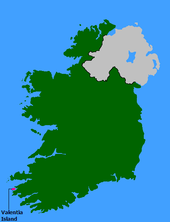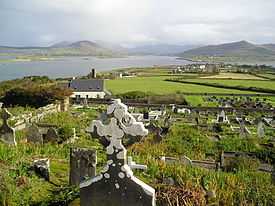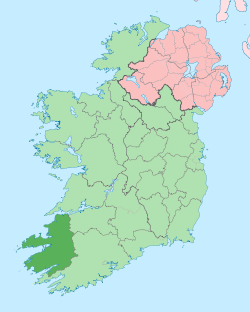Valentia Island
| Valentia Island Dairbhre | |
|---|---|
| Town | |
| Coordinates: 51°54′N 10°21′W / 51.9°N 10.35°WCoordinates: 51°54′N 10°21′W / 51.9°N 10.35°W | |
| Province | Munster |
| County | County Kerry |
| Population (2011) | |
| • Total | 665 |
| Time zone | WET (UTC+0) |
| • Summer (DST) | IST (WEST) (UTC+1) |
| Irish Grid Reference | V380764 |

Valentia Island (Irish: Dairbhre) is one of Ireland's most westerly points lying off the Iveragh Peninsula in the south-west of County Kerry. It is linked to the mainland by the Maurice O'Neill Memorial Bridge at Portmagee. A car ferry also departs from Reenard Point to Knightstown, the island's main settlement, from April to October. The permanent population of the island is 665 (CSO 2011)[1] and the island is approximately 11 kilometres (6.8 mi) long by almost 3 kilometres (1.9 mi) wide.
History
Valentia was the eastern terminus[3] of the first commercially viable transatlantic telegraph cable. The first attempt in 1857[4] to land a cable from Ballycarbery Strand on the mainland just east of Valentia Island ended in disappointment. After subsequent failures of cables landed at Knightstown in 1858 and Foilhommerum Bay in 1865,[5] the vast endeavor finally resulted in commercially viable transatlantic telegraph communications from Foilhommerum Bay to Heart's Content, Newfoundland in 1866. Transatlantic telegraph cables operated from Valentia Island for one hundred years, ending with Western Union International terminating its cable operations in 1966.
Prior to the transatlantic telegraph, American longitude measurements had a 2,800-foot (850 m) uncertainty with respect to European longitudes. Because of the importance of accurate longitudes to safe navigation, the U.S. Coast Survey mounted a longitude expedition in 1866 to link longitudes in the United States accurately to the Royal Observatory in Greenwich. Benjamin Gould and his partner A. T. Mosman reached Valentia on 2 October 1866. They built a temporary longitude observatory beside the Foilhommerum Cable Station to support synchronized longitude observations with Heart's Content, Newfoundland. After many rainy and cloudy days, the first transatlantic longitude signals were exchanged between Foilhommerum and Heart's Content on October 24, 1866.
In 1993, an undergraduate geology student discovered fossilised tetrapod trackways (51°55′51″N 10°20′38″W / 51.930868°N 10.343849°W), footprints in mud preserved in Devonian rocks on the north coast of the island. About 385 million years ago, a primitive vertebrate passed along a muddy shoreline in the equatorial swampland that is now southwestern Ireland and left prints as if in wet concrete. The prints were preserved by silt overlying them, and were converted to rock over the ages. The Valentia Island trackways are among the oldest signs of vertebrate life on land and have been studied extensively by the palaeontologist Dr Stössel.
Places of interest

The combined features and history of the island make it an attractive tourist destination, easily accessible from the popular Ring of Kerry route.
- Geokaun Mountain and Fogher Cliffs : the highest mountain on Valentia Island and the sea cliffs of 600 feet (180 m) on its northern face.
- On the northeast of the island stands Glanleam House amid sub-tropical gardens. Protected by windbreaks from Atlantic gales and never touched by frost, these gardens provide the mildest microclimate in Ireland. Starting in the 1830s, Sir Peter George Fitzgerald, the 19th Knight of Kerry (1808–1880),[6] planted these gardens and stocked them with a unique collection of rare and tender plants from the southern hemisphere, normally grown under glass in Ireland. The gardens are laid out in a naturalistic style as a series of walks. There are plants from South America, Australia, New Zealand (the tallest tree ferns in Europe), Chile and Japan. The gardens are memorialized in a selected golden-variegated Luma apiculata "Glanleam Gold" that originated as a sport in the garden. The gardens are open to the public.
- The slate quarry which reopened in 1998 provided slates for the British Houses of Parliament.[7]
- The island also hosts a heritage centre[8] which tells the story of the geology, human, natural and industrial history of the island, with exhibits on the Cable Station, the Marine Radio Station and the RNLI's Valentia Lifeboat Station.
- The Telegraph Field (or Longitude Field) is the site of the first permanent communications link between Europe and North America Transatlantic telegraph cables operated from Valentia Island from 1866.[5]
-

Dolmen Rock, western slope of Mt. Geokaun
-

Balleyhearney House, Balleyhearney East. 'Famine Era' hospital adjacent to the Knights' Wood.
-

Rare snowy day, Main Road, Valentia Island looking toward Knightstown, Valentia Harbour and Cahirciveen
-

Portion of the view from the summit of Mt. Geokaun ("yo-kawn"). Valentia Harbour and Cahirciveen are in the background
-

Portion of the view from the summit of Mt. Geokaun ("yo-kawn"). Valentia Harbour and Letter are in the background
-

View from Culloo Rock. Dingle Peninsula, Dingle Bay and the north shore of Valentia Island (including Folger Cliffs) are in the background.
-

Bray Head view looking west with Skellig Islands in distance
-

View of Portmagee Channel looking south-east from Bray Head
Weather station
The Valentia Island Weather Station is located 51° 56' 23"N, 10° 14'40"W and is 25 metres above the mean sea level. It is one of the 22 coastal weather stations whose reports are broadcast as part of the BBC Shipping Forecast. Valentia Observatory is part of Met Éireann, the Irish Meteorological Service. The observatory was set up in August 1868. Valentia island is, on average, the wettest weather station in Ireland. The monthly averages for Sunshine and Rainfall are based on 2010 statistics which are around average apart from July, which received only 40% of its normal sunshine hours and 219% of its normal rainfall. Valentia island also has a station for Navtex transmissions.
Climate
| Climate data for Valentia Island, County Kerry | |||||||||||||
|---|---|---|---|---|---|---|---|---|---|---|---|---|---|
| Month | Jan | Feb | Mar | Apr | May | Jun | Jul | Aug | Sep | Oct | Nov | Dec | Year |
| Record high °C (°F) | 14.8 (58.6) |
15.6 (60.1) |
20.7 (69.3) |
24.0 (75.2) |
27.2 (81) |
28.1 (82.6) |
29.7 (85.5) |
28.4 (83.1) |
28.4 (83.1) |
22.5 (72.5) |
19.8 (67.6) |
15.5 (59.9) |
29.7 (85.5) |
| Average high °C (°F) | 9.8 (49.6) |
9.8 (49.6) |
11.0 (51.8) |
12.5 (54.5) |
14.9 (58.8) |
16.7 (62.1) |
18.1 (64.6) |
18.2 (64.8) |
17.19 (62.94) |
14.3 (57.7) |
11.8 (53.2) |
10.3 (50.5) |
13.7 (56.7) |
| Daily mean °C (°F) | 7.3 (45.1) |
7.2 (45) |
8.2 (46.8) |
9.4 (48.9) |
11.8 (53.2) |
13.7 (56.7) |
15.4 (59.7) |
15.4 (59.7) |
14.1 (57.4) |
11.7 (53.1) |
9.3 (48.7) |
7.8 (46) |
10.9 (51.6) |
| Average low °C (°F) | 4.7 (40.5) |
4.6 (40.3) |
5.4 (41.7) |
6.3 (43.3) |
8.4 (47.1) |
10.8 (51.4) |
12.7 (54.9) |
12.6 (54.7) |
11.2 (52.2) |
9.0 (48.2) |
6.8 (44.2) |
5.3 (41.5) |
8.2 (46.8) |
| Record low °C (°F) | −6.8 (19.8) |
−7.3 (18.9) |
−5.1 (22.8) |
−2.3 (27.9) |
0.5 (32.9) |
2.8 (37) |
5.3 (41.5) |
3.3 (37.9) |
2.4 (36.3) |
−1.4 (29.5) |
−4.0 (24.8) |
−7.7 (18.1) |
−7.7 (18.1) |
| Average precipitation mm (inches) | 174 (6.85) |
124 (4.88) |
124 (4.88) |
97 (3.82) |
94 (3.7) |
95 (3.74) |
99 (3.9) |
115 (4.53) |
125 (4.92) |
177 (6.97) |
169 (6.65) |
165 (6.5) |
1,558 (61.34) |
| Avg. precipitation days (≥ 1.0 mm) | 19 | 15 | 17 | 13 | 13 | 12 | 14 | 14 | 15 | 18 | 19 | 18 | 187 |
| Avg. snowy days | 1.0 | 0.8 | 0.7 | 0.3 | 0 | 0 | 0 | 0 | 0 | 0 | 0.1 | 0.7 | 3.6 |
| Average relative humidity (%) | 84 | 83 | 83 | 79 | 78 | 81 | 84 | 84 | 84 | 85 | 85 | 84 | 83 |
| Mean monthly sunshine hours | 43.4 | 62.2 | 93 | 156 | 182.9 | 159 | 139.5 | 136.4 | 117 | 83.7 | 54 | 40.3 | 1,267.4 |
| Source: | |||||||||||||
Sport
Valentia Young Islanders GAA is the local Gaelic Athletic Association club.
Valentia is a popular fishing location, and Valentia waters hold the Irish records for conger eel, red sea bream, Ray's bream and lesser spotted dogfish.
Notable people
Valentia was considered home to Mug Ruith, a powerful blind druid in Irish mythology.
The O'Sullivans, headed by the O'Sullivan Beare, owned much of Valentia until the 17th century.[9]
The noted naturalist Maude Jane Delap lived and worked in Knightstown, carrying out important research into the marine life surrounding Valentia and identifying many new species.[10]
Valentia is the home of former Gaelic footballer, Mick O'Connell and the birthplace of John J "Scéilig" O'Kelly, leader of Sinn Féin from 1926.
Gaelic footballer Ger O'Driscoll was born on Valentia Island.
The American solo rock climber Michael Reardon died on 13 July 2007 at the Fogher Cliffs of Valentia Island when he was swept out to sea following a successful climb.
Gerald Spring Rice, 6th Baron Monteagle of Brandon was brought up on the island, as were many other members of the Spring Rice family.[11]
See also
References
- ↑ Electoral Division Valencia (CSO Area Code ED 19025). Census of Ireland 2011 (Report). 1 – Population Classified by Area (Central Statistics Office of Ireland). Valencia.
- ↑ Alan Ryan Hall.
- ↑ The Atlantic Cable, Smithsonian Institution, USA.
- ↑ John R. Isaac, 1857 — Laying the Atlantic Telegraph Cable from Ship to Shore, History of the Atlantic Cable & Undersea Communications.
- ↑ 5.0 5.1 The Telegraph Field.
- ↑ The FitzGerald (Knights of Kerry) Papers (MIC/639 and T/3075), Public Record Office of Northern Ireland, UK.
- ↑ http://www.cromane.net/valentia.htm
- ↑ FTL Design.
- ↑ Toby Barnard, ‘O'Sullivan Beare, Philip (b. c.1590, d. in or after 1634)’, Oxford Dictionary of National Biography, Oxford University Press, 2004
- ↑ Mulvihill, Mary (2003). Ingenious Ireland: A County-by-County Exploration of the Mysteries and Marvels of the Ingenious Irish. Dublin: Simon and Schuster. pp. 397–398. ISBN 0684020947. Retrieved 10 November 2014.
- ↑ The Guards Magazine, 'Captain The Lord Monteagle of Brandon' http://guardsmagazine.com/obits_lordmonteagle.html
External links
- Valentia Island Portal
- Valentia Heritage Centre
- Valentia Island Annual Music Festival
- Travel Information
- The Tetrapod Trackways
- The Laying of the Atlantic Telegraph Cable
- Telegraph Cable History Trail
- Cable History at the Valentia Heritage Centre
- Alan Hall - Sculptor of the First Transatlantic Cable and First message sent to USA 1856 Memorial
- Submarine Telegraphs, Their History, Construction, and Working by Charles Bright
- Linking European and American Longitude
- IEEE History Center: County Kerry Transatlantic Cable Stations, 1866
- The Transatlantic Longitude as Determined by the Coast Survey Expedition of 1866
- Valentia Island Sea Angling
- The Telegraph Field - Valentia Island
- Resources and Links about the Telegraph Field on Valentia Island
- Irelandbyways site Valentia Information
| ||||||||||||||||||||||
Further reading
Browne, E.T., The fauna and flora of Valencia Harbour on the west coast of Ireland. Proc. R.Ir. Acad., ser.3,5, 667-854
